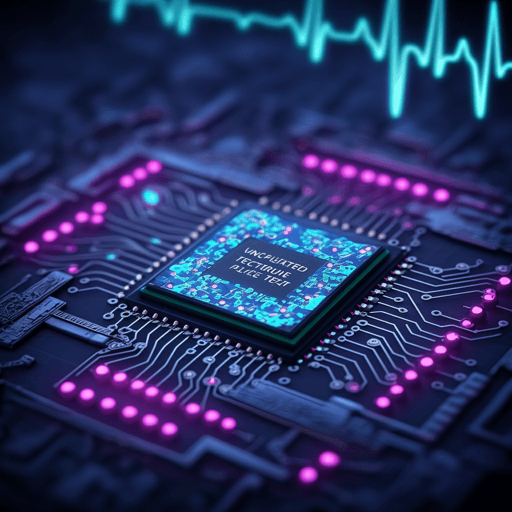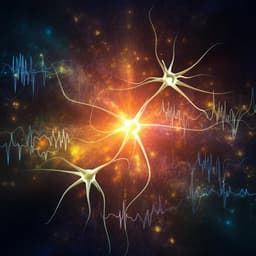
Engineering and Technology
A neuromorphic physiological signal processing system based on VO₂ memristor for next-generation human-machine interface
R. Yuan, P. J. Tiw, et al.
Physiological signal processing is advanced by a VO₂ memristor–based neuromorphic system that encodes sparse, high-fidelity spikes and implements compact LIF/ALIF neurons within an LSNN, achieving 95.83% and 99.79% for arrhythmia classification and epileptic seizure detection. Research conducted by Rui Yuan, Pek Jun Tiw, Lei Cai, Zhiyu Yang, Chang Liu, Teng Zhang, Chen Ge, Ru Huang, and Yuchao Yang.
~3 min • Beginner • English
Introduction
Physiological signals reflect the electrical activity of specific body parts and provide valuable information about mood, cognition, and health. Deviations from normal patterns may indicate underlying problems, such as arrhythmias in ECG signals or epileptic seizures in EEG signals. Automated physiological signal processing systems can assist diagnosis, provide second opinions, and detect subtle patterns. Traditional processing pipelines convert analog signals to digital via ADCs, store them in memory, and compute on digital units, but massive data movement between memory and computation limits speed and power efficiency. Neuromorphic computing, inspired by the brain, offers parallel, event-driven processing that is energy efficient and well-suited to spatiotemporal physiological signals. Prior CMOS-based neuromorphic systems have demonstrated feasibility but often suffer area and energy inefficiencies due to complex auxiliary circuits and bulky capacitors. Memristors, with rich ion dynamics and neuron/synapse-like electrical behavior, are promising for compact neuromorphic architectures. While hardware LIF neurons are widely reported, hardware ALIF neurons—key to improved temporal computation—are less explored and can be optimized further. A complete memristor-based physiological signal processing system featuring efficient spike encoding and a more biologically plausible network with ALIF neurons had not been reported. This work introduces such a system based on VO₂ memristors, featuring an asynchronous spike encoder that preserves temporal information and a decision LSNN with VO₂-based LIF and ALIF neurons, achieving high accuracy on arrhythmia classification and epileptic seizure detection.
Literature Review
Neuromorphic systems based on CMOS have been used for physiological signals, including ECG classification and real-time anomaly detection, but they often require complex circuits and large capacitors, leading to area and energy inefficiency. Memristive devices have demonstrated neuron/synapse-like behaviors and have enabled diverse neuromorphic functions, including diffusive dynamics and phase-change neurons, neuristors built with Mott memristors, and learning with resistive switching synapses. Hardware implementations of LIF neurons are abundant, but few hardware implementations of ALIF neurons exist; those reported leave room for optimization. Level-crossing ADCs and delta modulators inspire event-driven encoding with nonuniform sampling, which is advantageous for sparse data and low power; however, previous encoders often rely on ADC/DAC and complex control circuits. This work builds upon these foundations by using VO₂ memristors with symmetric thresholds and volatility to simplify encoder and neuron designs and by integrating ALIF neurons into LSNNs to enhance temporal computing on physiological signals.
Methodology
Device fabrication: 20 nm VO₂ films were epitaxially grown on c-Al₂O₃ substrates by pulsed-laser deposition (308 nm XeCl excimer laser, ~1 J cm⁻², 3 Hz) at 530 °C in flowing O₂ at 2.0 Pa, then cooled to room temperature at 20 °C min⁻¹. The planar VO₂ memristor has a 400 nm channel length and 2 µm width. Au/Ti electrodes (40 nm/5 nm) with 400 nm spacing were patterned by EBL, evaporation, and lift-off. Device characterization: Stable volatile resistive switching was confirmed via I–V cycling (100 cycles), showing thresholds at approximately ±3.4 V and holding voltages at approximately ±1.45 V. COMSOL simulations modeled Joule-heating-induced metal–insulator transitions with filament formation/annihilation. Uniformity and stability were assessed: cycle-to-cycle coefficients of variation for Vth/Vhold were 0.65%, 0.86%, 0.31%, and 1.68%; during transient oscillations over 1000 periods, C_v for Vth and Vhold were 0.73% and 0.48%. Switching speeds were <70 ns (off-to-on) and <60 ns (on-to-off). Endurance exceeded 6.5×10⁶ cycles. Threshold switching was robust under various ambient pressures and N₂ environment. LIF neuron circuit: A VO₂ memristor in parallel with capacitance C_p and series load resistor R_L, plus a readout resistor R_O (50 Ω) to convert current to voltage. The capacitor charges until its voltage exceeds Vth, triggering memristor switching to LRS and spike generation; discharge occurs until below Vhold, returning to HRS. Spiking frequency depends on R_L, input voltage, and parallel capacitance (larger R_L or larger C_p reduces frequency; larger input voltage increases frequency). An LTSPICE VO₂ model (polarity-independent symmetrical I–V) with comparator logic and RC elements (R_O, C_O) modeled finite switching times and matched experimental results. ALIF neuron circuit: Built on LIF with an adaptive control path including M₁ (common-emitter amplifier), M₂ (charging C₂ to raise V_g), and M₃ (adaptive leakage path). Each spike increases V_g, turning on M₃ more to increase leakage current, slowing subsequent integration (spike frequency adaptation). Adaptation decays via R₃ providing a discharge path for C₂. Time constants were set such that the adaptive time constant τ_a = R₃C₂ is larger than the membrane time constant τ_m = (R_VO2 + R_L)C₁. LTSPICE simulations showed frequency modulation by V_g and by W/L ratios of M₂ and M₃, with saturation behavior when adaptation is strong. Asynchronous spike encoder: A capacitive-divider input amplifier, intermediate op-amp, VO₂ memristor, and feedback reset branch implement event-based encoding. The gout node changes only when input changes; amplified gout is applied to VO₂. Crossing ±Vth triggers memristor LRS, producing a high voltage across R₃ that activates PMOS/NMOS feedback to reset gout; voltage drops below ±Vhold returns memristor to HRS, ending the spike. Two antiparallel diodes separate positive/negative spikes into UP/DOWN channels. The encoder’s delta threshold δ (input change per spike) is tunable via intermediate stage amplification α = R₂/R₁ (δ ∝ Vth/R_off × R₂/R₁). LTSPICE simulations validated accurate reconstruction of sine and ECG waveforms; larger α reduces δ, increasing accuracy but raising spike rate/energy. Reliability analysis introduced Vth fluctuations in the SPICE model, quantified reconstruction MSE, and showed VO₂ device’s low variation yields accurate and repeatable encoding. LSNN architecture and training: A 3-layer LSNN (input spiking layer; hidden recurrent layer with LIF and ALIF neurons; low-pass filter; output layer). Random synaptic delays were assigned at initialization. Neuron membrane dynamics were discretized: V_m updates depend on effective resistance R_eff, input current X, and adaptation leakage I_leak for ALIF; threshold crossing resets to V_hold_eff. V_g evolves per V_g(t+Δt) = β V_g(t) + (1−β) R₃ I_s z, with β = exp(−Δt/R₃C₂), z as spike indicator. Training used BPTT with categorical cross-entropy plus spike regularization for sparse firing; surrogate gradients approximated spiking non-differentiability. Datasets and preprocessing: For ECG (MIT-BIH), ECGs were resampled to 1800 Hz, split into 1000 timesteps per heartbeat (~556 ms), normalized to 0–0.6 V. 2000 heartbeats total: N=1000, VEB=500, SVEB=250, F=250; split into 1664 training and 336 testing samples; inputs encoded into UP/DOWN spikes plus a CUE signal. For EEG (CHB-MIT), patient 1 data resampled to 800 Hz; training used 2530 non-contiguous clips (1000 timesteps, 18 channels; N=1265, E=1265), testing used 2878 contiguous clips over one hour with only 31 epileptic clips; inputs encoded into 18 UP and 18 DOWN channels plus CUE. Evaluation and post-processing: EEG performance measured by G-mean (geometric mean of sensitivity and specificity). A decoupled post-processing step applied moving average (optimized window=9) and thresholding (optimized threshold=0.8) to contiguous LSNN outputs to suppress random false positives while preserving true positive clusters. Area efficiency analysis: With device/circuit optimization, VO₂ LIF and ALIF neurons can occupy ~41.3 µm² and ~53.4 µm², respectively; the encoder ~2231 µm², smaller than comparable CMOS/memristor encoders. Discussion included prospects for scaling VO₂ gaps to ≤100 nm and interfacing VO₂ neurons/encoders with non-volatile crossbar arrays.
Key Findings
• VO₂ memristor device performance: Stable volatile threshold switching at ±3.4 V (Vth) and ±1.45 V (Vhold); switching speeds <70 ns (off→on) and <60 ns (on→off); endurance >6.5×10⁶ cycles; robust operation across ambient conditions. Cycle-to-cycle variation (C_v) for thresholds/holding: 0.65%, 0.86%, 0.31%, 1.68%; dynamic operation C_v for Vth and Vhold over 1000 periods: 0.73% and 0.48%.
• Neuromorphic encoding: The memristor-based asynchronous spike encoder produces sparse, on-demand UP/DOWN spike trains that accurately reconstruct input signals; δ threshold is tunable via amplifier gain α, trading accuracy for spike rate/energy. Simulations with sine and ECG signals show high-fidelity reconstruction; encoding reliability is high despite Vth fluctuations due to low device variation.
• Neuron circuits: Compact VO₂-based LIF neuron exhibits controllable spiking frequency via R_L, input voltage, and parallel capacitance; ALIF neuron shows spike-frequency adaptation modulated by V_g and transistor W/L ratios, enabling temporal processing.
• LSNN performance on ECG arrhythmia classification: Using a 3×100×4 LSNN (60 LIF, 40 ALIF), maximum test accuracy reached 95.83% on a 4-class task (N, VEB, SVEB, F). Mixed LIF+ALIF LSNN outperformed LIF-only by ~18% and generally matched or slightly exceeded ALIF-only with fewer adaptive neurons, supporting a mixed design.
• LSNN performance on EEG epileptic seizure detection: With a 37×40×2 LSNN (16 ALIF), raw contiguous testing achieved accuracy 82.70%, sensitivity 100%, specificity 82.51%. Post-processing (moving average window=9, threshold=0.8) improved to accuracy 99.79%, sensitivity 90.32%, specificity 99.89%, dramatically reducing false positives while retaining clustered true positives.
• Area efficiency: Optimized VO₂ LIF and ALIF neurons estimated at ~41.3 µm² and ~53.4 µm²; encoder ~2231 µm², nearly an order smaller than similar implementations; combined area, speed, and energy superior to CMOS/memristor alternatives.
• System-level advantages: Achieved state-of-the-art metrics with 1–3 orders fewer weights than prior works; sparse event-driven encoding and ALIF-enhanced LSNN provide strong temporal computing capacity with small networks suitable for compact wearable devices.
Discussion
The system demonstrates that VO₂ memristors can efficiently implement both event-driven encoding and biologically inspired neuron dynamics, alleviating the von Neumann bottleneck for physiological signal processing. By exploiting symmetric thresholds and volatility, the encoder avoids ADC/DAC and complex control circuits, achieving sparse, timing-preserving spike representations that allow accurate signal reconstruction and reduced energy. The inclusion of ALIF neurons provides spike-frequency adaptation, a key mechanism for temporal processing such as negative imprinting, markedly improving performance over LIF-only networks while requiring only a fraction of adaptive neurons. Device uniformity, speed, and endurance underpin reliable operation. Area, speed, and energy advantages suggest suitability for next-generation human-machine interfaces and wearable medical devices. Post-processing further enhances specificity in imbalanced, real-world EEG detection scenarios without complicating training. The approach is extensible to other temporal signals and can be integrated with emerging non-volatile crossbar arrays for even higher compactness, contingent on careful co-optimization of device and circuit parameters.
Conclusion
A complete memristor-based neuromorphic physiological signal processing hardware system using VO₂ devices was presented, featuring an asynchronous, sparse spike encoder and a decision LSNN with compact VO₂ LIF and ALIF neurons. The encoder preserves temporal information to enable accurate reconstruction, and the ALIF neurons deliver superior temporal computation. The system achieved 95.83% accuracy on ECG arrhythmia classification and 99.79% accuracy (90.32% sensitivity, 99.89% specificity after post-processing) on EEG epileptic seizure detection with small LSNNs. Device characteristics (uniform symmetric thresholds, volatility, speed, endurance) and circuit simplicity yield area and energy efficiencies ideal for wearable biomedical applications. Future work includes further device scaling, reduction or replacement of capacitors via parasitics, comprehensive co-optimization of circuit components, expanding datasets to reduce false positives without post-processing, and integrating with non-volatile crossbar arrays to build ultra-compact, end-to-end physiological processing architectures.
Limitations
• Raw LSNN outputs for EEG exhibited high false positives, likely due to limited training data and class imbalance; performance relied on a separate post-processing step to improve specificity.
• The study primarily used simulations and circuit-level demonstrations; full-scale hardware integration and long-term in situ validation remain to be demonstrated.
• Capacitors dominate neuron circuit area; although estimates show small areas, further reduction or replacement with parasitic capacitances is needed for maximal density.
• Generalization across patients and broader physiological datasets was limited (e.g., EEG from patient 1); larger, diverse datasets and cross-subject validation are necessary for robust deployment.
• The encoder’s accuracy–energy trade-off via amplification factor requires careful tuning per application, and robustness to device aging or environmental variations, while promising, needs extended field testing.
Related Publications
Explore these studies to deepen your understanding of the subject.







